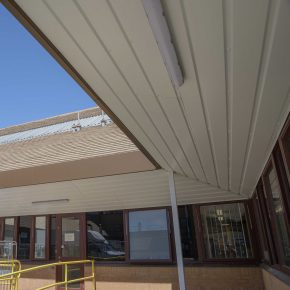
How rooflights can offer energy savings and carbon reductions
Primarily used to flood natural light into buildings and structures, the rooflight’s role has evolved significant in recent decades to deliver a whole range of requirements, including improving thermal performance and reducing demand on lighting, heating, cooling and ventilation systems.
Until 2006, it was thought that the introduction of rooflights into an existing building would compromise its thermal performance – as glass would not have provided the same level of insulation as opaque areas.
However, research carried out by Oxford Brookes University, funded by the National Association of Rooflight Manufacturers (NARM), changed these misconceptions about the role of rooflights in the overall energy efficiency of buildings.
The study demonstrated that the optimum level of roof lighting (in appropriate buildings) was 15-20% of the floor area. NARM has since gone on to publish a more recent report based on independent research by Elmhurst Energy in 2014.
Reducing carbon through rooflights
The report aims to show that energy savings and carbon reductions can be made on existing UK industrial and commercial buildings by increasing the amount of natural light and improving and adding automatic control to lighting systems.
The study assesses three different buildings, designed for educational, industrial and retail use, to explore the impact a number of improvements measures would have.
Elmhurst Energy and NARM created a range of scenarios to apply to the buildings, demonstrating how increasing the quality of daylight within buildings would affect carbon emissions, costs and energy use.
Elmhurst Energy study
The retail building, a self-contained Homebase store with a total floor area of 3,930 metres squared, benefited from a 29% reduction in carbon emissions due to improvements to the rooflights, while only 11% savings could be made by enhancing the electric lights and lighting control systems.
In the 994 metre squared industrial building, the same improvements would deliver a 23% and 14% reduction respectively.
The primary school however scored far lower than the other buildings, as only 51.4% of the floor area was in rooflit zones, therefore improvements studied only affect around half of the building.
The same improvements to the roof lights and control systems saw only an 8.9% reduction in carbon emissions, whilst Improvements to the electric lights and lighting controls similarly underperformed, offering savings of 3.7%.
Significant savings
All three building types showed significant savings to be made in both running costs and carbon emissions, achieved through using better insulated rooflights – such as the leak-free EcoGard from Lonsdale Metal – and better availability of natural light through the rooflights.
With ever more stringent Building Regulations and end users demanding better performing buildings, roof glazing systems are becoming ever more popular within the construction industry.
Combined with modern lighting controls, the introduction of natural daylight through a high performance rooflight system can allow artificial lighting to be reduced and improve energy efficiency throughout a building, whilst also offering an attractive and welcoming environment for its occupants.
For further information, please contact NARM using the contact details on our website, where you will be directed to the appropriate person.
Click here to visit The Rooflight Association's website
Visit Supplier's page
Latest news

26th April 2024
Alumasc Skyline and Rainwater package specified at Weston-super-Mare Hospital
A package of products from Alumasc Water Management Solutions (AWMS) has been used for the external refurbishment of the roofline at Weston General Hospital in Weston-Super-Mare.
Posted in Aluminium Products, Articles, Building Industry News, Building Products & Structures, Building Services, Building Systems, Case Studies, Cladding, Drainage Services, Drainage, Guttering, Soffits & Fascias, Fascias, Restoration & Refurbishment, Retrofit & Renovation, Roofs, Walls
26th April 2024
Hush Acoustics optimises fleet operations by securing FORS Gold accreditation
Hush Acoustics has invested in the safety and sustainability of its commercial vehicle fleet by achieving Gold status in the Fleet Operator Recognition Scheme (FORS).
Posted in Acoustics, Noise & Vibration Control, Articles, Building Industry News, Building Products & Structures, Building Regulations & Accreditations, Building Services, Ceilings, Facility Management & Building Services, Floors, Health & Safety, Insulation, Restoration & Refurbishment, Retrofit & Renovation, Site Preparation, Sustainability & Energy Efficiency, Walls, Waste Management & Recycling
26th April 2024
Safeguard Europe: Penetrating damp - how to diagnose the damage
As Safeguard gets ready to deliver another informative session of one of its most popular webinars, the company outlines some of the most common reasons for rain penetration through brickwork.
Posted in Articles, Bricks & Blocks, Building Industry Events, Building Industry News, Building Products & Structures, Building Services, Continuing Professional Development (CPD's), Damp & Waterproofing, Facility Management & Building Services, Information Technology, Posts, Render, Restoration & Refurbishment, Retrofit & Renovation, Seminars, Training, Walls
25th April 2024
ADSA: Competence Initiative Makes Progress
The Joint Competency Initiative (JCI), in which the Automatic Door Suppliers Association (ADSA) is involved, is finalising its first framework for installers within the door, gates and shutter industry.
Posted in Access Control & Door Entry Systems, Architectural Ironmongery, Articles, Building Associations & Institutes, Building Industry Events, Building Industry News, Building Products & Structures, Building Regulations & Accreditations, Building Services, Continuing Professional Development (CPD's), Doors, Facility Management & Building Services, Health & Safety, Innovations & New Products, Publications, Research & Materials Testing, Restoration & Refurbishment, Retrofit & Renovation, Security and Fire Protection, Site Preparation
 Sign up:
Sign up: